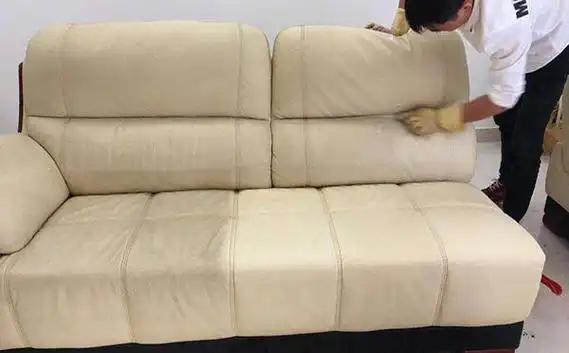Save your investment of 10,000 yuan! A complete guide to cleaning and maintaining a leather sofa
Abstract:
A set of high-quality odinės sofos is the soul of the living room and an important investment for the family. Ignoring its cleaning and maintenance will not only cause the leather to crack, fade, and stain penetration, but will also greatly shorten its service life (studies have shown that the life of a leather sofa with regular maintenance can be extended by 5-8 years). This article systematically analyzes the scientific cleaning techniques and core maintenance methods of leather sofas in six major home scenes to help you protect the value of the sofa and the style of your home.

1. Cleaning tools: accurate selection, twice the result with half the effort
The choice of cleaning tools and dosage forms is directly related to the life and effect of leather.
- For daily floating dust, dry wiping with a microfiber cloth is the first choice to avoid friction damage with ordinary rags (the International Leather Crafts Association emphasizes the importance of tool fineness).
- Professional leather cleaners (such as Leather Master Cleaning Foam) are highly targeted and less corrosive, far better than strong household cleaning products such as detergent (the American Home Furnishing Association points out that the wrong cleaner is one of the main causes of leather damage).
- Stubborn stains can be gently brushed with a soft brush (such as an old toothbrush) and a special cleaner to avoid scratching the surface.
2. Graded stain removal: dealing with common challenges
Adopt targeted strategies based on the type and degree of stains.
- Ordinary stains: Dip a cotton cloth in a slightly damp solution (clean water or diluted neutral soap solution) and wipe it immediately.
- Ink pen marks: Use an eraser to gently rub it within the golden time for significant results (the “Home First Aid Manual” recommends this method).
- Deep dirt: Use a special leather cleaner and a soft cloth to clean in circles, then use a clean wet cloth to remove the residue, and finally dry it thoroughly.
- Natural polishing: Egg white contains mild protein. Dipping a soft cloth in it and wiping it gently can enhance the gloss, but it is only suitable for small areas (derived from traditional leather care wisdom).
3. Environmental shield: temperature and humidity balance to avoid strong light
Environmental factors are the invisible pushers of leather aging.
- Continuous direct sunlight is the culprit for leather fading and hardening (the “Home Materials Science” journal confirms the decomposition of collagen by ultraviolet rays). It can be avoided by adjusting the position or using curtains.
- Direct air conditioning causes local dryness and cracking, and it is also necessary to stay away from the radiator.
- Keep the space ventilated and maintain a relative humidity of 40%-60% for the best. Extreme dryness or humidity accelerates leather aging (North American Leather Association Humidity Guide).
4. Daily maintenance: the truth is revealed in the details
Regular and gentle care is the basis for maintaining the state of the sofa.
- Pat the seat and edges after sitting for a long time to help the filling rebound and prevent mechanical dents.
- Regularly (every 2-3 months) use a soft brush to remove dust from gaps to avoid dirt accumulation and wear on leather.
- After cleaning or during quarterly care, use high-quality leather care agents (such as ColourLock Leather Shield) to nourish and restore oil balance.
5. Professional Depth: Revitalize the Vitality of Sofas
Periodic professional care is indispensable.
- Use professional leather cleaners to thoroughly clean every quarter, followed by deep nourishment.
- Dealing with moisture: In humid areas, dry seasons can be selected every year, and weak sunlight (best in the early morning) can be used for short periods of time for several times, no more than 1 hour each time, to help it dry and sterilize naturally (a combination of traditional experience and modern science).
- For severe damage, burns or large-area dyeing, be sure to seek help from professional leather restorers, and avoid strong treatment by yourself to cause secondary damage.
6. Smart Purchase: Start from the Ground to Avoid Deep Pitfalls
Purchase decisions have a profound impact on the difficulty and effect of later maintenance.
- Face the “tendon marks”: The vein marks on the back of natural cowhide are real marks, not quality defects. When purchasing, pay attention to whether their position affects the appearance (the international leather mark certification allows reasonable natural marks).
- Understand “fat wrinkles”: The neck and abdomen leather lines are naturally stretched, giving the sofa a unique charm and comfortable ductility, which is the characteristic of genuine leather.
- When the budget is sufficient, full-grain top-layer cowhide is preferred. Its durability, breathability and repair potential far exceed that of split leather or artificial leather (durability evaluation data of “Consumer Furniture Purchase Guide”).
Santrauka:
Leather sofas are not cold objects, but home partners that carry time. Scientific graded cleaning (precise agent selection + graded decontamination), creating an ideal environment (avoiding light and adjusting humidity), insisting on daily maintenance (gentle patting + regular vacuuming), and implementing professional maintenance (deep cleaning + nourishing and repairing), the four-dimensional integration can protect it from the ruthless erosion of time. Wise judgment when purchasing can reduce the difficulty of maintenance from the source. Every careful wipe is a solemn commitment to quality life – a set of leather sofas that are treated gently will return the warmth of home and the owner’s taste with increasingly mellow texture and comfort for a long time.
